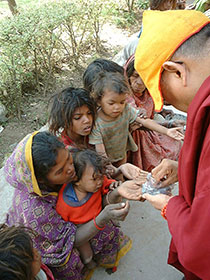- Home
- FPMT Homepage
Foundation for the Preservation of the Mahayana Tradition
The FPMT is an organization devoted to preserving and spreading Mahayana Buddhism worldwide by creating opportunities to listen, reflect, meditate, practice and actualize the unmistaken teachings of the Buddha and based on that experience spreading the Dharma to sentient beings. We provide integrated education through which people’s minds and hearts can be transformed into their highest potential for the benefit of others, inspired by an attitude of universal responsibility and service. We are committed to creating harmonious environments and helping all beings develop their full potential of infinite wisdom and compassion. Our organization is based on the Buddhist tradition of Lama Tsongkhapa of Tibet as taught to us by our founders Lama Thubten Yeshe and Lama Thubten Zopa Rinpoche.
- Willkommen
Die Stiftung zur Erhaltung der Mahayana Tradition (FPMT) ist eine Organisation, die sich weltweit für die Erhaltung und Verbreitung des Mahayana-Buddhismus einsetzt, indem sie Möglichkeiten schafft, den makellosen Lehren des Buddha zuzuhören, über sie zur reflektieren und zu meditieren und auf der Grundlage dieser Erfahrung das Dharma unter den Lebewesen zu verbreiten.
Wir bieten integrierte Schulungswege an, durch denen der Geist und das Herz der Menschen in ihr höchstes Potential verwandelt werden zum Wohl der anderen – inspiriert durch eine Haltung der universellen Verantwortung und dem Wunsch zu dienen. Wir haben uns verpflichtet, harmonische Umgebungen zu schaffen und allen Wesen zu helfen, ihr volles Potenzial unendlicher Weisheit und grenzenlosen Mitgefühls zu verwirklichen.
Unsere Organisation basiert auf der buddhistischen Tradition von Lama Tsongkhapa von Tibet, so wie sie uns von unseren Gründern Lama Thubten Yeshe und Lama Thubten Zopa Rinpoche gelehrt wird.
- Bienvenidos
La Fundación para la preservación de la tradición Mahayana (FPMT) es una organización que se dedica a preservar y difundir el budismo Mahayana en todo el mundo, creando oportunidades para escuchar, reflexionar, meditar, practicar y actualizar las enseñanzas inconfundibles de Buda y en base a esa experiencia difundir el Dharma a los seres.
Proporcionamos una educación integrada a través de la cual las mentes y los corazones de las personas se pueden transformar en su mayor potencial para el beneficio de los demás, inspirados por una actitud de responsabilidad y servicio universales. Estamos comprometidos a crear ambientes armoniosos y ayudar a todos los seres a desarrollar todo su potencial de infinita sabiduría y compasión.
Nuestra organización se basa en la tradición budista de Lama Tsongkhapa del Tíbet como nos lo enseñaron nuestros fundadores Lama Thubten Yeshe y Lama Zopa Rinpoche.
A continuación puede ver una lista de los centros y sus páginas web en su lengua preferida.
- Bienvenue
L’organisation de la FPMT a pour vocation la préservation et la diffusion du bouddhisme du mahayana dans le monde entier. Elle offre l’opportunité d’écouter, de réfléchir, de méditer, de pratiquer et de réaliser les enseignements excellents du Bouddha, pour ensuite transmettre le Dharma à tous les êtres. Nous proposons une formation intégrée grâce à laquelle le cœur et l’esprit de chacun peuvent accomplir leur potentiel le plus élevé pour le bien d’autrui, inspirés par le sens du service et une responsabilité universelle. Nous nous engageons à créer un environnement harmonieux et à aider tous les êtres à épanouir leur potentiel illimité de compassion et de sagesse. Notre organisation s’appuie sur la tradition guéloukpa de Lama Tsongkhapa du Tibet, telle qu’elle a été enseignée par nos fondateurs Lama Thoubtèn Yéshé et Lama Zopa Rinpoché.
Visitez le site de notre Editions Mahayana pour les traductions, conseils et nouvelles du Bureau international en français.
Voici une liste de centres et de leurs sites dans votre langue préférée
- Benvenuto
L’FPMT è un organizzazione il cui scopo è preservare e diffondere il Buddhismo Mahayana nel mondo, creando occasioni di ascolto, riflessione, meditazione e pratica dei perfetti insegnamenti del Buddha, al fine di attualizzare e diffondere il Dharma fra tutti gli esseri senzienti.
Offriamo un’educazione integrata, che può trasformare la mente e i cuori delle persone nel loro massimo potenziale, per il beneficio di tutti gli esseri, ispirati da un’attitudine di responsabilità universale e di servizio.
Il nostro obiettivo è quello di creare contesti armoniosi e aiutare tutti gli esseri a sviluppare in modo completo le proprie potenzialità di infinita saggezza e compassione.
La nostra organizzazione si basa sulla tradizione buddhista di Lama Tsongkhapa del Tibet, così come ci è stata insegnata dai nostri fondatori Lama Thubten Yeshe e Lama Zopa Rinpoche.
Di seguito potete trovare un elenco dei centri e dei loro siti nella lingua da voi prescelta.
- 欢迎 / 歡迎
简体中文
“护持大乘法脉基金会”( 英文简称:FPMT。全名:Foundation for the Preservation of the Mahayana Tradition) 是一个致力于护持和弘扬大乘佛法的国际佛教组织。我们提供听闻,思维,禅修,修行和实证佛陀无误教法的机会,以便让一切众生都能够享受佛法的指引和滋润。
我们全力创造和谐融洽的环境, 为人们提供解行并重的完整佛法教育,以便启发内在的环宇悲心及责任心,并开发内心所蕴藏的巨大潜能 — 无限的智慧与悲心 — 以便利益和服务一切有情。
FPMT的创办人是图腾耶喜喇嘛和喇嘛梭巴仁波切。我们所修习的是由两位上师所教导的,西藏喀巴大师的佛法传承。
繁體中文
護持大乘法脈基金會”( 英文簡稱:FPMT。全名:Found
ation for the Preservation of the Mahayana Tradition ) 是一個致力於護持和弘揚大乘佛法的國際佛教組織。我們提供聽聞, 思維,禪修,修行和實證佛陀無誤教法的機會,以便讓一切眾生都能 夠享受佛法的指引和滋潤。 我們全力創造和諧融洽的環境,
為人們提供解行並重的完整佛法教育,以便啟發內在的環宇悲心及責 任心,並開發內心所蘊藏的巨大潛能 — 無限的智慧與悲心 – – 以便利益和服務一切有情。 FPMT的創辦人是圖騰耶喜喇嘛和喇嘛梭巴仁波切。
我們所修習的是由兩位上師所教導的,西藏喀巴大師的佛法傳承。 察看道场信息:
- FPMT Homepage
- News/Media
-
- Study & Practice
-
-
- About FPMT Education Services
- Latest News
- Programs
- New to Buddhism?
- Buddhist Mind Science: Activating Your Potential
- Heart Advice for Death and Dying
- Discovering Buddhism
- Living in the Path
- Exploring Buddhism
- FPMT Basic Program
- FPMT Masters Program
- FPMT In-Depth Meditation Training
- Maitripa College
- Lotsawa Rinchen Zangpo Translator Program
- Universal Education for Compassion & Wisdom
- Online Learning Center
-
- Prayers & Practice Materials
- Overview of Prayers & Practices
- Full Catalogue of Prayers & Practice Materials
- Explore Popular Topics
- Benefiting Animals
- Chenrezig Resources
- Death & Dying Resources
- Lama Chopa (Guru Puja)
- Lama Zopa Rinpoche: Compendium of Precious Instructions
- Lama Zopa Rinpoche: Life Practice Advice
- Lama Zopa Rinpoche Practice Series
- Lamrim Resources
- Mantras
- Prayer Book Updates
- Purification Practices
- Sutras
- Thought Transformation (Lojong)
- Audio Materials
- Dharma Dates - Tibetan Calendar
- Translation Services
- Publishing Services
- Ways to Offer Support
- Prayers & Practice Materials
-
- Teachings and Advice
- Find Teachings and Advice
- Lama Zopa Rinpoche Advice Page
- Lama Zopa Rinpoche: Compendium of Precious Instructions
- Lama Zopa Rinpoche Video Teachings
- ༧སྐྱབས་རྗེ་བཟོད་པ་རིན་པོ་ཆེ་མཆོག་ནས་སྩལ་བའི་བཀའ་སློབ་བརྙན་འཕྲིན།
- Podcasts
- Lama Yeshe Wisdom Archive
- Buddhism FAQ
- Dharma for Young People
- Resources on Holy Objects
- Teachings and Advice
-
-
*If a menu item has a submenu clicking once will expand the menu clicking twice will open the page.
-
-
- Centers
-
- Teachers
-
- Projects
-
-
-
-
*If a menu item has a submenu clicking once will expand the menu clicking twice will open the page.
-
-
- FPMT
-
- Shop
-
-
-
The Foundation Store is FPMT’s online shop and features a vast selection of Buddhist study and practice materials written or recommended by our lineage gurus. These items include homestudy programs, prayers and practices in PDF or eBook format, materials for children, and other resources to support practitioners.
Items displayed in the shop are made available for Dharma practice and educational purposes, and never for the purpose of profiting from their sale. Please read FPMT Foundation Store Policy Regarding Dharma Items for more information.
-
-
9
The Benefits of Monasteries and Nunneries
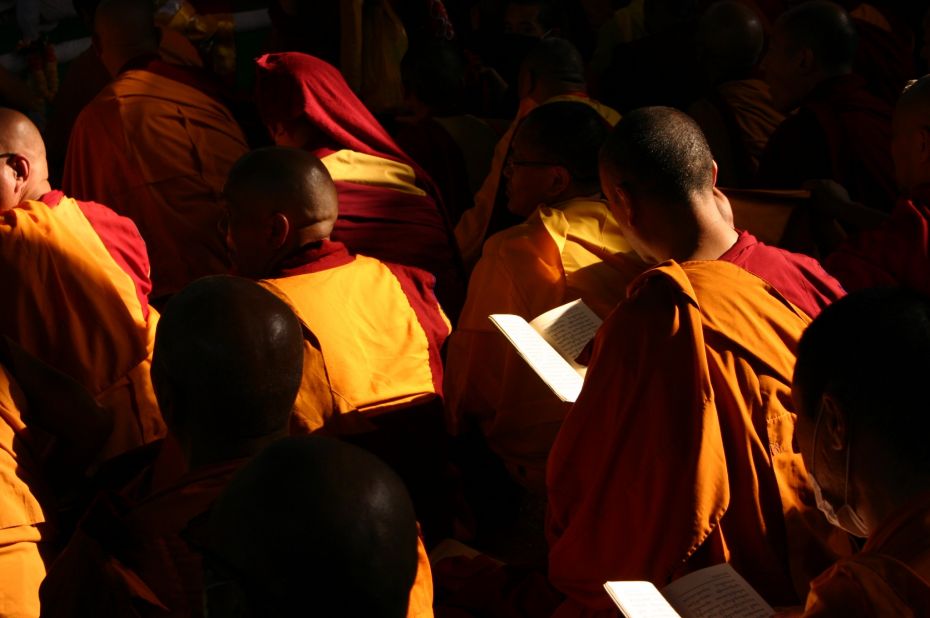
Monks attending the Kalachakra in Bodhgaya, India, January 2017. Photo by Cynthia Karena.
Are monasteries and nunneries necessary? Lama Zopa Rinpoche recently answered the question with a resounding “Yes!” and explained some of the benefits of monastic communities. The question was also examined by Ven. Tenzin Legtsok, an American monk in the geshe studies program at Sera Je Monastic University. He wrote a detailed response in an article called “Guardians of the Way: The Importance and Benefits of Monastics Living Together” published in the newsletter of the International Mahayana Institute (IMI), FPMT’s community of nuns and monks. Since Ven. Legtsok’s analysis complements the precious words of Rinpoche, Mandala has drawn on both sources to describe why monasteries and nunneries remain important in today’s world.
“When Prince Gautama first took up the life of a wandering mendicant,” wrote Ven. Tenzin Legtsok, “he initially sought instruction from several renowned teachers of the day. It is recorded that during this time he lived and practiced near these teachers among groups with other trainees. At the time of the Buddha, most of his ordained followers lived together in order to receive guidance from Shariputra, Maudgalyayana, and other senior disciples. Until today nearly all monastics in the Theravada and Chinese Buddhist traditions live within monastic communities. The vast majority of Tibetan and Himalayan monks and nuns live as part of one or another monastic community. Yet precious few communities of Western Buddhist ordained people have arisen.”
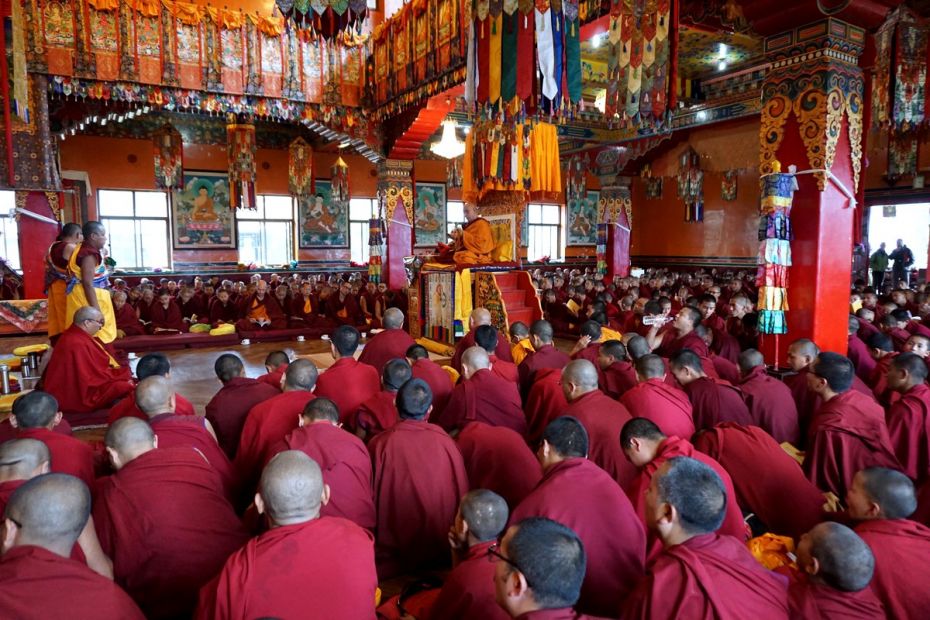
Jangtse Chöje Lobsang Tenzin Rinpoche leading prayers at Monlam, Kopan Monastery, Nepal, March 2017. Photo by Ven. Lobsang Sherab.
There’s the rub: Western monks and nuns may keep in touch online, regularly meet with other monastics, or stay at Dharma or retreat centers, but many do not live in “brick-and-mortar” monastic communities. This sometimes has to do with the lives of the individuals themselves and sometimes with a shortage of monasteries and nunneries. As well, modern Buddhism is largely oriented toward lay practice and Dharma centers, which means that lay support for monastics is at times in short supply. Unfortunately, not everyone sees the point of monasteries and nunneries nowadays.
Lama Zopa Rinpoche, however, does see the point, and has described more than once the benefits of monasteries and nunneries for Sangha, lay people, and the Dharma. In 2009, Rinpoche said, “A monastery means two things. One is having holy objects for people to purify the mind, collect extensive merit, and have realizations of the path to enlightenment. Second is especially for monks and nuns to live there in their vows, in retreat away from the city and the distractions to their vows.” His focus, therefore, was on two factors: first, the benefits to visitors—mainly lay people—who see holy objects, make offerings, and so on, and second, the need for a supportive place for monastics to live in their vows.
Rinpoche’s more recent advice, given in 2016, reiterated those two points as well as referencing a third: the important role monastic communities play in preserving the Dharma.
On the latter issue, Rinpoche explained: “The Buddha came approximately 2,800 years ago, and the Buddhadharma still exists. This is because of monasteries and the education they provide. In Tibet, the complete Buddhadharma existed, meaning the Lesser Vehicle teachings as well as the Mahayana sutra and Mahayana tantra teachings. These were taught by Buddha, came to Tibet from Nalanda, and were preserved and disseminated in full. If people had become monastics but just stayed in the fields or on bare mountains, like monkeys, then this would not have happened. It is entirely due to monasteries that this happened.” Thus Rinpoche underlined that not just individual ordained Sangha are needed, but also communities of Sangha living together.

Lama Zopa Rinpoche and Ven. Lozang Yönten, Russia, 2015. Photo by Ven. Tenzin Chodron.
Rinpoche then focused on the need for monastics to live in conducive circumstances and the benefits of them having this opportunity, saying, “Without monasteries, the Sangha would have no place to live together, no place to do practice, to study. They can’t just live on the bare mountains or in the fields, without any shelter. Monasteries are normally not in the city, but away from the city, away from distraction. And those living in monasteries are not just away from distractions but also have their monastery’s rules and the discipline of vinaya to protect their minds. The main purpose of monasteries is to subdue the mind, to keep the mind in peace, in Dharma, to keep away distractions, which are causes of attachment, anger, and so forth. So monasteries are built away from cities, in isolated places, away from obstacles. It is like this so monks and nuns can live in their vows better. Monasteries help them do this.
“In Tibet, the Nyingma, Kagyu, and Sakya put in place many monasteries. Then Lama Tsongkhapa came and established Ganden Monastery. His disciples established Sera Je and Mey, then Ganden Shartse and Jangtse, and Drepung Loseling and Gomang. These are just the main monasteries, but there are many others. In these monasteries, you can study sutra and tantra in depth, like the Pacific Ocean so, so deep, so vast. Even for Mongolians it was the best place to come and study. There were so many Mongolians studying in Tibetan monasteries and becoming geshes. They studied all of Lama Tsongkhapa’s teachings, the whole lamrim, and they knew the great Lamrim Chenmo by heart. Then they went back to Mongolia and created monasteries there, branches of Sera, Ganden, Drepung, and so on, which gave monastics there a place to practice and study, so those monastics didn’t have to live in the fields or on the bare mountains. The benefit was unbelievable, unbelievable, unbelievable.”

Debate at Sera Je Monastery. Ven. Tenzin Gache answers questions from his classmates Vens. Losang Tsering, Losang Dorje, and Jamyang Dorje, India, 2015. Photo by Sera Je A/V Dept.
Rinpoche then pointed out that monastic communities do not just preserve the Dharma and provide a place for monastics, but also help lay people directly and immediately. In this regard, he explained that, “In Tibet and Mongolia, those outside the monasteries were able to collect merit by coming to the monasteries and making offerings. By building the monasteries they collected so much merit. In this way lay people collected unbelievable merit by making offerings to the Sangha, requesting or doing practices, making offerings to holy objects, etc. Then they also sent many of their children to the monasteries to be educated. The Buddha said that building shelters for monks and providing for their needs creates eons of merit, and this is merit that increases and cannot be exhausted. In the Mindfulness Sutra it says that even in hundreds of eons one cannot come to the end even of explaining the merits and benefits, they are so unbelievable, unbelievable, unbelievable. Buddha said in that sutra that whoever has arranged for the needs of the Sangha will always have more and more virtue. That virtue can never be used up even in ten million thousand eons.”
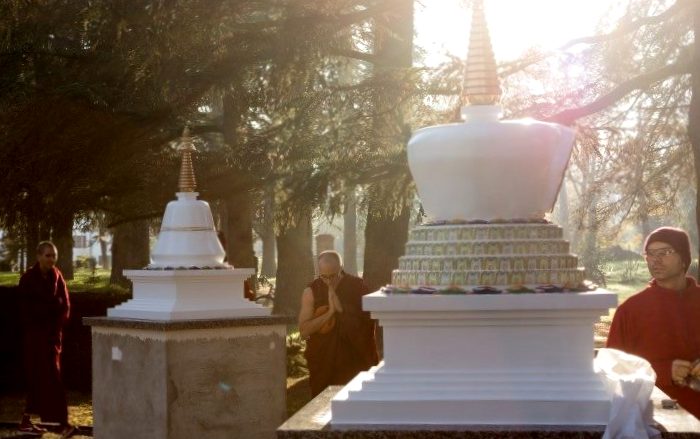
New stupas at Nalanda Monastery in France on their day of consecration, December, 2016. Photo from Nalanda Monastery via Facebook.
Rinpoche continued to describe the great merit that lay people can collect by helping to build monasteries or create holy objects, saying, “Here are some of the benefits if you help create monasteries, gompas, and holy objects such as statues, stupas, and scriptures, in which abide Buddha, Dharma, and Sangha. However many atoms the object has, for that many eons you become a universal king. And when there is a universal king in the world, there is so much good fortune for everyone. People are able to live in the ten virtues and there are other incredible, incredible benefits. And being a universal king is just along the way, because ultimately you will attain enlightenment. That means you exhaust all the mistakes and complete all the realizations, and you free numberless sentient beings from the oceans of samsaric sufferings and bring them to peerless happiness. That is the meaning of sang-gyä (Tibetan for “buddha”): the total cessation of all obscurations and the completion of all realizations.”
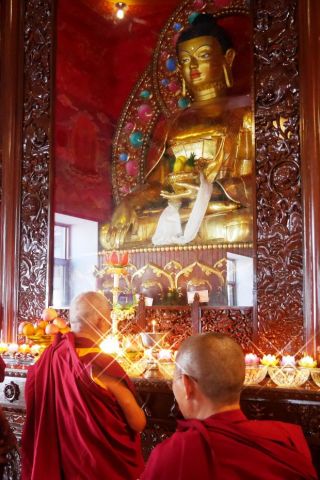
Lama Zopa Rinpoche pays respect to holy images at Kopan nunnery, Nepal, February 2017. Photo by Ven. Holly Ansett.
“As well,” he summed up, referring to both lay people and Sangha, “monasteries and gompas where there are holy objects of the Buddha, Dharma, and Sangha—statues, stupas, and scriptures—are called ‘abiding places’—nä-khang in Tibetan. What is abiding is the Buddha, Dharma, and Sangha. So an ‘abiding place’ is a great, great place to subdue the mind, collect extensive merits, and achieve enlightenment. Even the name nä-khang is incredible.” In this way, Rinpoche emphasized that monastic communities benefit everyone, lay and ordained.
Rinpoche went on to explain that Dharma centers for lay people also have many benefits, but they do not replace monasteries. He said, “Centers where there are resident teachers, where people come to listen to the Dharma, to study Dharma, to meditate, to collect merit, to purify defilements, to take refuge, to generate bodhichitta, and to dedicate practice for all sentient beings also have unbelievable benefits. There, you can learn compassion and bodhichitta. Each time you practice there, you help the six realms’ sentient beings by dedicating, not leaving out even one. Not one ant or one maggot or even one slug is left out; all your practices are dedicated for them. You practice Dharma there for them.” But Rinpoche did not suggest that centers have the same role in preserving and spreading the Dharma as monastic communities, or in giving ordained Sangha a conducive situation to study, practice, and live in their vows.
Rinpoche concluded by saying that his words were “just a drop, not much, just a drop of the benefits of monasteries” and passed on the following quote that he translated from a life story of the Buddha:
Abiding in the house there will be happiness
And one will have contemplation
And great insight and so forth
By offering monasteries and temples to ordained Sangha.
And this is admired by the buddhas.
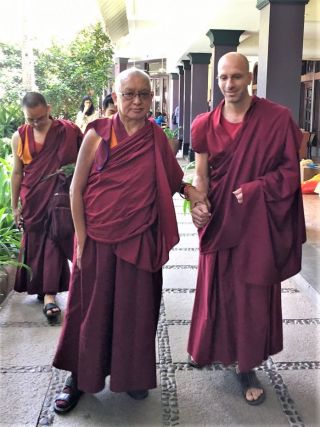
Lama Zopa Rinpoche and Ven. Tenzin Legtsok, Bangalore, India, December 2016. Photo by Ven. Holly Ansett.
Ven. Legtsok echoed Rinpoche’s themes in his article, which he wrote in response to discussions about whether virtual communities for Sangha can replace physical ones. He first described why living together in community is essential for training monastics and preserving the Dharma, writing, “Every instance of suffering ever experienced by any sentient being has arisen from ignorance grasping at an inherently existent self. … Knowledge of this wisdom realizing selflessness, ultimate truth, and how to use it to eradicate suffering from the root is extremely rare and precious. So long as there are groups of people in the world who keep the knowledge of this truth alive, there is a way for others to gain freedom from suffering. A passageway is held open. … When there are no longer people who keep this truth alive, then the door, the only door, from a realm of darkness into a realm of light, has closed.
“Buddhist teachings are unique in the clarity with which they define and explain how to train in wisdom realizing selflessness to overcome afflictive emotions, their stains, and even obscurations to omniscience. … Groups of monks or nuns who devote their lives to upholding this truth are … called the Sangha because, by living in the pratimoksha vows, they are similar to, and follow the way of life deemed best by the arya Sangha. Where such an ordained Sangha exists, ideally the teachings of Shakyamuni Buddha are upheld. Where the teachings of the Buddha are upheld, there is a way for people to come to know how to free themselves from suffering.
“Although this path is open to all, through the ages it has been the responsibility of the ordained Buddhist Sangha to devote themselves wholly to training in, realizing, and teaching this path to subsequent generations. Thus the existence of a Buddhist Sangha is of inexpressible importance not just for ordained people but for the entire world.”
Hence, wrote Ven. Legtsok, Sangha living in their vows are crucial to sustaining the Buddha’s teachings, so that everyone can continue to access them. But why, he then asked, must they also live together in monastic communities?
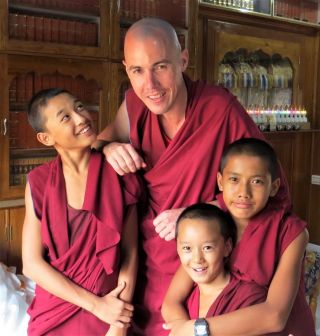
Ven. Jampa Khedrup with young house-mates, Sera Je Monastery, India, May 2016. Photo by Sonam Nyima.
“To fully inherit the torch of Dharma from previous generations,” he explained, “junior monastics must learn from knowledgeable elders. In order to make the Dharma available for future generations, elders must offer their guidance and insight gained through experience to juniors. This transmission requires a profound level of face-to-face communication among many people over extended periods of time. Moreover, transmission of wholesome values happens in an entirely organic fashion, based on juniors watching and learning from the uncontrived actions of dedicated elder monks and nuns. Individuals living alone lack access to such an organic process, and their growth will be stunted. If the continuity of this stream of communication declines and breaks, future generations will lack living examples of people wholeheartedly striving for liberation and enlightenment, not to mention those who’ve achieved it, and will thus find it extremely difficult to discover and believe in the possibility of liberation or the path to it.”
Speaking from his own experience of monastery life, Ven. Legtsok continued, “Some further advantages of being part of a monastic community are: we are directly part of something bigger then ourselves by contributing to the life of a community that has the potential to benefit many people in a profound way. We gain the companionship of friends who share our deep commitment to spiritual development in the Buddhist path. We have access to more teachers, teachings, and role models then if we live alone. When we have questions or wish to discuss our doubts, others with the relevant knowledge and experience are close at hand. As we develop, we have opportunities to support other monastics in their practice and studies.
“At different periods in our monastic life, the community we live in benefits us in different ways. As a newly ordained person it trains and informs us how to wear the robes, how to keep the vows, how to skillfully deal with different situations, and offers us role models of people who have been able to keep their vows well for a long time. When we engage in meditation retreats it helps provide for us. When we become weak with sickness or old age, the community looks after and nurses us. When we die, our fellow monks and nuns pray for us. In dependence on others in the community we even create causes to have close companions on our spiritual path in future lives.

Nuns of Chenrezig Institute. Back row from left: Vens. Lozang Tsondru, Thubten Damcho, Lozang Tseten, Lozang Rigsal and Lozang Wangmo. Front row from left: Vens. Lozang Tsultrim, Gyalten Tsultrim, Tenzin Palyon, Thubten Tongnyi and Thubten Pema. Chenrezig Institute Gompa, Australia, November 2016.
“When we are studying, a monastery or nunnery offers us the opportunity to study with more supportive conditions and fewer obstacles. Mundane tasks like shopping, cooking, cleaning, and maintenance, etc., are shared by all, freeing up much time and mental space. By studying the Dharma in a community, especially a large one, we are exposed to more well qualified teachers and students with a broad range of ideas and perspectives, deepening and enriching the quality of our learning. The greater our wisdom of hearing, the greater our wisdom of contemplation will become, and accordingly the greater will be our wisdom gained through meditation.
“Recognizing such benefits, monastic scholars of the past naturally formed major communities of study and practice, like Nalanda and Vikramashila in India, and the ‘Three Great Seats’ [Ganden Monastery, Sera Monastery, and Drepung Monastery] in Tibet. The great yogi saint, Shabkar, said that the Three Seats where the most powerful objects of offering in Tibet. His Holiness the Dalai Lama and Lama Zopa Rinpoche often comment that without the Three Seats and the two tantric colleges it would be nearly impossible to produce individuals with a broad, deep, and accurate understanding of both sutra and tantra. … To contribute to the thriving of such a community is profoundly meaningful. Having the opportunity to be part of one is something to treasure.”
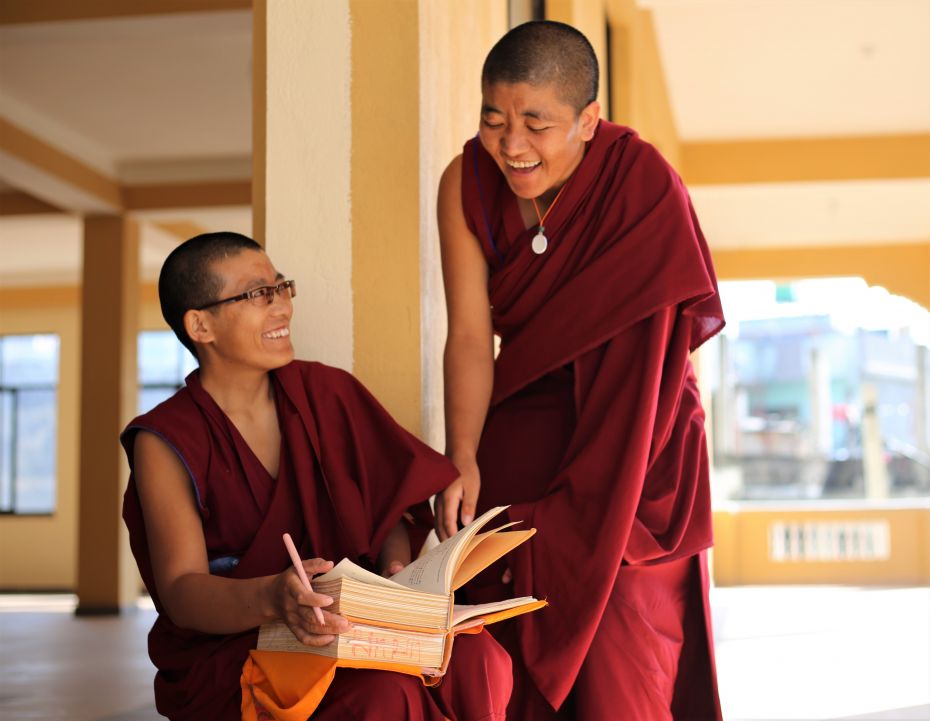
Kopan nuns Vens. Lobsang Rigzin and Lobsang Namdrol memorizing, 2017. Photo by Ven. Tenzin Tsomo.
It is not always easy to live in a monastery, admitted Ven. Legtsok, saying, “I suspect that because they are powerful virtuous objects, monastic communities cause uncommonly strong purification to happen!” He concluded on a personal note: “The first few years at Sera were one of the most difficult times in my life. Having stayed on despite the difficulties, now I sometimes think it is as close to a pure land on earth as I could find. There’s no other satisfaction like quietly sitting in my room in the late afternoon reading profound passages from a Dharma text, going to debate them in the evening with classmates, and then further reflecting on their meaning as we slowly chant the Heart Sutra and other prayers under the vast night sky. At such moments I often pray that in the future many others will be able to experience this way of life.”
Given the benefits of monastic communities, we can add our prayers to Ven. Legtsok’s—and ponder our own role in helping monasteries and nunneries to thrive.
Compiled and edited by Mandala associate editor Donna Lynn Brown.
Contribute to the needs of ordained monks and nuns through the Supporting Ordained Sangha Fund.
Mandala is offered as a benefit to supporters of the Friends of FPMT program, which provides funding for the educational, charitable and online work of FPMT.
- Home
- News/Media
- Study & Practice
- About FPMT Education Services
- Latest News
- Programs
- New to Buddhism?
- Buddhist Mind Science: Activating Your Potential
- Heart Advice for Death and Dying
- Discovering Buddhism
- Living in the Path
- Exploring Buddhism
- FPMT Basic Program
- FPMT Masters Program
- FPMT In-Depth Meditation Training
- Maitripa College
- Lotsawa Rinchen Zangpo Translator Program
- Universal Education for Compassion & Wisdom
- Online Learning Center
- Prayers & Practice Materials
- Overview of Prayers & Practices
- Full Catalogue of Prayers & Practice Materials
- Explore Popular Topics
- Benefiting Animals
- Chenrezig Resources
- Death & Dying Resources
- Lama Chopa (Guru Puja)
- Lama Zopa Rinpoche: Compendium of Precious Instructions
- Lama Zopa Rinpoche: Life Practice Advice
- Lama Zopa Rinpoche Practice Series
- Lamrim Resources
- Mantras
- Prayer Book Updates
- Purification Practices
- Sutras
- Thought Transformation (Lojong)
- Audio Materials
- Dharma Dates – Tibetan Calendar
- Translation Services
- Publishing Services
- Teachings and Advice
- Find Teachings and Advice
- Lama Zopa Rinpoche Advice Page
- Lama Zopa Rinpoche: Compendium of Precious Instructions
- Lama Zopa Rinpoche Video Teachings
- ༧སྐྱབས་རྗེ་བཟོད་པ་རིན་པོ་ཆེ་མཆོག་ནས་སྩལ་བའི་བཀའ་སློབ་བརྙན་འཕྲིན།
- Podcasts
- Lama Yeshe Wisdom Archive
- Buddhism FAQ
- Dharma for Young People
- Resources on Holy Objects
- Ways to Offer Support
- Centers
- Affiliates Area
- Teachers
- Projects
- Charitable Projects
- Make a Donation
- Applying for Grants
- News about Projects
- Other Projects within FPMT
- Support International Office
- Projects Photo Galleries
- Give Where Most Needed
- FPMT
- Shop
Translate*
*powered by Google TranslateTranslation of pages on fpmt.org is performed by Google Translate, a third party service which FPMT has no control over. The service provides automated computer translations that are only an approximation of the websites' original content. The translations should not be considered exact and only used as a rough guide.In Buddhism, we are not particularly interested in the quest for intellectual knowledge alone. We are much more interested in understanding what’s happening here and now, in comprehending our present experience, what we are at this very moment, our fundamental nature.







